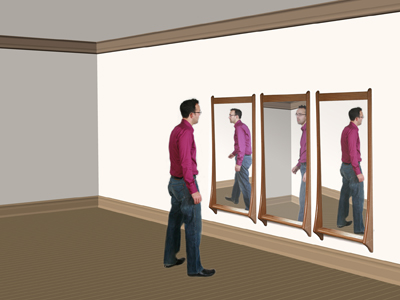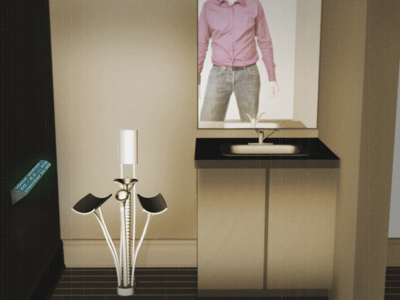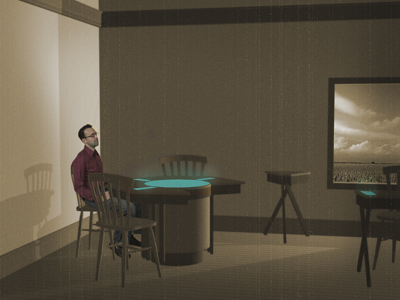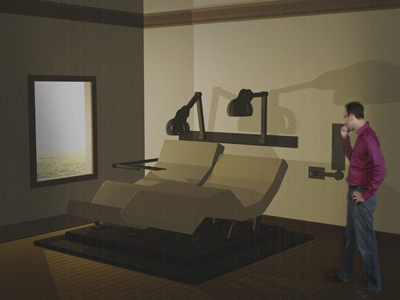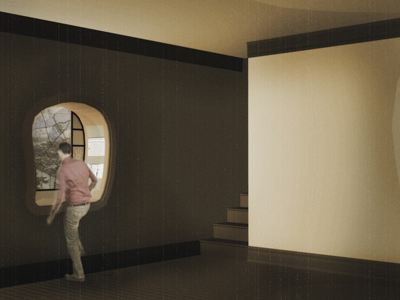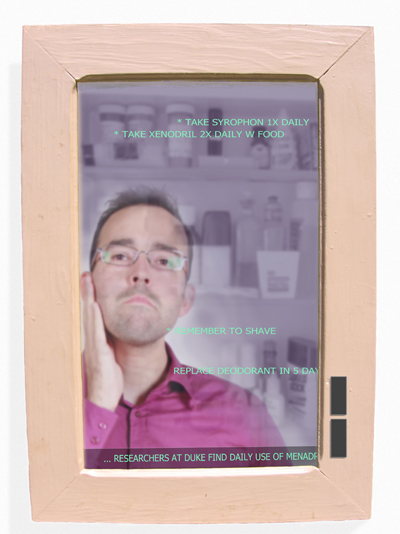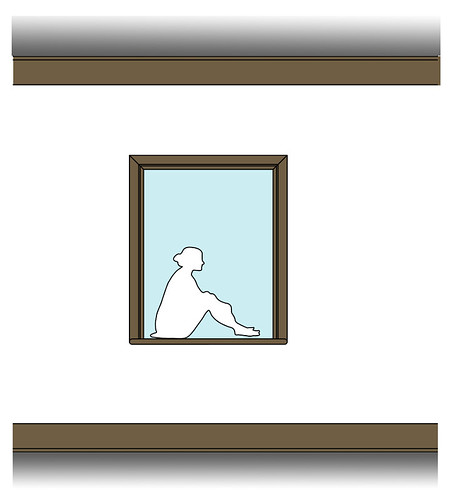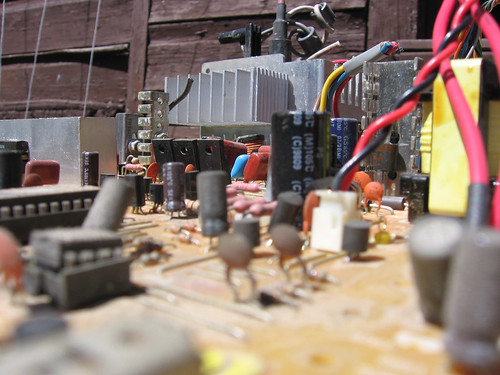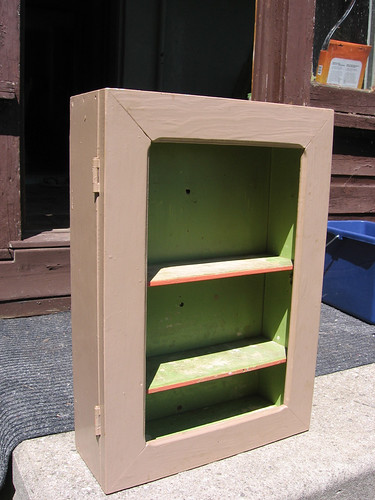11.04.2009
More Pictures from the Cyborg House
Also, just to be clear, this is whimsy:
10.16.2009
Lincoln Memorial in DC

I caught this photo of the Lincoln Memorial down in DC last week. The Lincoln Memorial of course is an important symbol of freedom in the epicenter of the land of the free. It is designed in the manner of a Doric temple, turned on its side. Within is a giant-sized statue of Lincoln, sitting majestically in a chair, looking out over the Mall.
Between Technological Flesh and The Technological Field
https://rcpt.yousendit.com/754357419/72a0997afd66d36a2e2aa37e141cf82e
Get it while its hot! 242 pages of burning technological love. The link will expire, I believe, on Tuesday the 20th of October.
The updated abstract can be found here. This link will not expire, nor is this abstract a working abstract any more.
9.15.2009
Images of the Cyborg House

 The bed of the Future is fully automated, and responds to your needs. If you would like to sleep supine, the bed flattens out, but if you would like to read in bed it positions itself upright. This enables a great deal of individual flexibility for you and your bedmate. You may have the two halves of your bed in completely different positions to fit your body, your temperament or your mood. If you wish to be intimate, at the flick of a switch the two halves snap into alignment!
The bed of the Future is fully automated, and responds to your needs. If you would like to sleep supine, the bed flattens out, but if you would like to read in bed it positions itself upright. This enables a great deal of individual flexibility for you and your bedmate. You may have the two halves of your bed in completely different positions to fit your body, your temperament or your mood. If you wish to be intimate, at the flick of a switch the two halves snap into alignment!
8.24.2009
The Joy of Patent Surfing
I only recently discovered the amazing resource of Google Patents but have been having a great time perusing it since I did. Sometimes I find myself drifting by there (internet exploration, if figured as motion, is really a derive) for research purposes and end up totally embroiled, flipping from one patent to another. This happens of course because all of the patents are linked to one another through citation.
It's the images that are the most compelling! What a fascinating graphic lexicon is at work. Line drawings I am fairly familiar with, but these have such strange texture and shadowing techniques and the labels are totally bizarre. Even patent applications from 2009 look hand-drawn, with funny jagged lettering and loopy leaders.
Here's the one that I was looking at today that made me want to share this private form of entertainment. I frankly have little idea what is being described. I recommend not reading anything about the application until you've looked at all of the diagrams in series, it'll be more fun that way.
8.19.2009
'spoonangoogle'
8.16.2009
Team North Blog
http://www.team-north.com/blog/
8.14.2009
Archi-culture film
Archiculture Teaser from arbuckle industries on Vimeo.
8.08.2009
Abstract Update
7.23.2009
Funk Up Your Window

Again following up on my windows of the future post, just imagine that you could hook up your window to play an audio visualization to suit the music that you are playing in the enclosed space. This would both be neat on the inside and really interesting on the outside.
Distributed Ventilation System

Below I found myself imagining that the ventilation purpose of the window had been extracted from it, miniaturized and distributed across the envelope of the building. This could provide something like 'task ventilation', similar to 'task lighting'. A central computer could sense which activities are going on in which part of the buildng and provide conditioned air to suit. A smart system would also be able to take into account the air-pressure on different sides of the building so as to design ideal ventilation patterns. Such patterns could be helped along by small turbines built into the distributed ventilation units themselves (which I am also imagining would contain micro heating and cooling filaments).
Anyways, the above sectional diagram is meant to illustrate how this might work (while maintaining adequate sound isolation of roms).
7.22.2009
Catherine Richards and the Codification of Romance
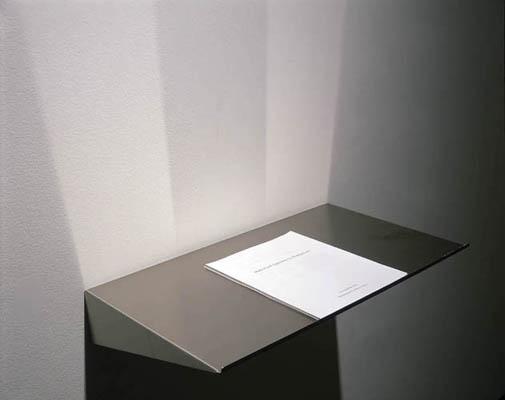
I was recently surveying some work by the Ottawa-based artist, Catherine Richards. In particular I was diverted by a piece of hers called Method and Apparatus for Finding Love, 2000. For this project Richards has chosen the patent as her site, locating the work of art actually within a patent application. The patent applied for is a sort of machine that, using very simple metrics, purports to a) determine your attractiveness, and b) match you up with acceptable mates (ie. about your level of attractiveness, quantifiably ascertained). This kind of codification of ‘romance’ would seem bizarre if it weren’t so consistent with actual available technologies ranging from biosensors reading skin conductivity, heart rate and pupil dilation, to people-matching programs such as lavalife, etc. This brutal simplification of such central human experience has two principal effects on me: a) it saddens, and b) I feel its straight forward pragmatism to be kind of liberating. If neither my romantic attractiveness, my capacity for romance, nor this deep beehive of emotions and desires are either special or mysterious, then what am I?
Sociology and psychology have been observing the repeated and predictable patterns in our behaviour for over a century now and they perform a similar function of reduction, demystifying the human shell. Am I, as the psychologist Guattari declares, just the result of ‘forces of subjectification’? An individual, yes, but not a subject, per se, at all?
Yet as disconcerting as it is to be such a straightforward, predictable, and codifiable thing, it carries with it a great deal that is of comfort. As we know from cybernetics, codification is great for making things work together: it’s really the whole point. If two machines are operating in the same language then you can plug them into each other, you can network them. It’s the same with humans: our great systems depend on our predictable and understandable behaviour, or perhaps, if you will, our performance.
Which, of course, is not new. Authoritarian powers have always imagined their subjects to be regular and consistent. All systems of organization and domination have required a certain regularity to their parts, implicitly or explicitly, and of course this is one of the purposes served by our institutions such as psychiatry and even more obviously, law. We have Michel Foucault to thank for making this so clear back in the 1960s.
What is striking for me is that it is also kind of comforting! Realizing that we are but simple machines, engineered to network with other machines, removes a great deal of the burden from our shoulders, after all. If we malfunction we can be fixed. ‘You are not alone,’ as the large banner above Main Street reads here in Cambridge in a bid to spread awareness of depression, which frankly I’m not sure if I should find comforting or terrifying in a Big Brother kind of way. Perhaps the real driving force behind all ‘human science’ is just to render us more appropriate for this vast networking project we call civilization. And maybe the best solution to alienation would really be just to give in to the insidious forces of codification and quantification: there is safety in numbers, no?
With thanks to N. Katherine Hayles for her insightful commentary on Richard's work which inspired these thoughts, which can be found in the catalog for Richard's Excitable Tissues exhibit from 2003
7.20.2009
Windows of the Future!
The text component of my thesis (when it's written!) will indeed engage with cybernetic organisms both as depicted in fiction and as they are emerging in reality (or should I maybe say we?). Although I am considering diagramming what the 'cyborg subject of the future' might look like as one aspect of the thesis, the design components will not deal with the cyborg subject, per se, at all (by which I am referring to the typically imagined, Terminator-style cyborg).
If, however, we consider all apparatae to be extensions of the human body, and the house to be an apparatus, then the infusion of cybernetics into this 'second skin' does constitute an example of our cyborg-becoming. At any rate, that is what I have chosen to concern myself with. Rather than dealing directly and solely with how the senses of space and place so central to who we are are changing as we incorporate technology into our bodies, I am looking at designing instances in which the architecture itself becomes 'plugged-in'. For example, rather than imagining and describing how we could wear a portable computer which gives us direct retinal access to every document ever published, I am more interested in investigating how we could use a coffee table to interact with that same database. This interest is predicated on two observations: 1st, that our current manner of interacting with computation and information is impoverished and unfortunately biased towards the visual, the most disembodying of the senses; and 2nd that, as Hiroshi Ishii has said, quoted by James Geary, "to actually physically feel something enriches our perception of it and allows us to interact with the environment as we were meant to." By distributing computing throughout the entire house we are no longer 'fixed' to the computer, allowing us to use both our mind and our body simultaneously in navigating a layered world of bits and atoms.
Below, I imagine a window:
 Freed of the traditional structural constraints of lumber or of masonry (for instance by using structural insulated panels or some other distributed structural system) the window could be any shape. What shape should it be? Here, being a window seat, it is intended to fit the human body on the one side, and allow the 'user' to interact with information on the other side. It's also, I noticed, the shape of a 'D'.
Freed of the traditional structural constraints of lumber or of masonry (for instance by using structural insulated panels or some other distributed structural system) the window could be any shape. What shape should it be? Here, being a window seat, it is intended to fit the human body on the one side, and allow the 'user' to interact with information on the other side. It's also, I noticed, the shape of a 'D'.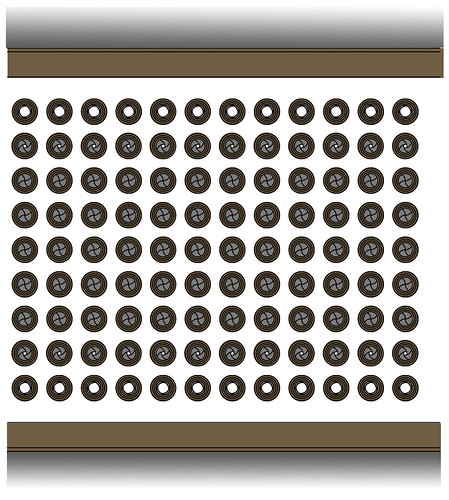 Alternately, the functions of the window (light, communication, ventilation, etc) could be miniaturized and distributed. Above I have attempted to miniaturize and distribute the ventilation function of the window. Ventilation could be controlled very accurately this way, for particular tasks. I have a sketch that shows how this would work on the scale of the house that I will post soon.
Alternately, the functions of the window (light, communication, ventilation, etc) could be miniaturized and distributed. Above I have attempted to miniaturize and distribute the ventilation function of the window. Ventilation could be controlled very accurately this way, for particular tasks. I have a sketch that shows how this would work on the scale of the house that I will post soon.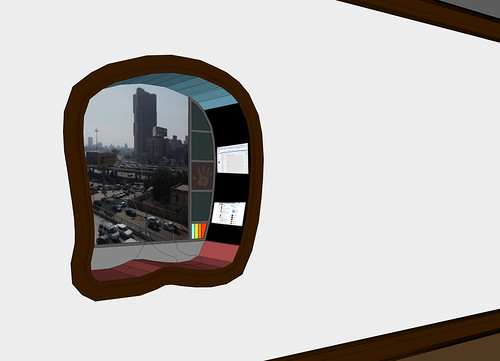 Here is the window seat in perspective. On the one side and on the bottom the unit is lined with foam, while on the other side and the top are two curved lcd screens. The screen opposite the 'user' is to give them access to things like social networking, weather, etc: augmentations of the traditional uses for a window.
Here is the window seat in perspective. On the one side and on the bottom the unit is lined with foam, while on the other side and the top are two curved lcd screens. The screen opposite the 'user' is to give them access to things like social networking, weather, etc: augmentations of the traditional uses for a window. The panel to the right of the glass gives access to various functions. The large black pieces are scroll-surfaces which the 'user' can use by brushing their hand against it: brushing one of them up opens the window; brushing it back down closes the window. The other two black surfaces are for controlling the opacity of the window and the density of the screen. Liquid crystal layered into the glass allows for information to be layered over the world outside. The buttons along the bottom control what information is being displayed - in the image above the weather forecast is being displayed. The reddish panel to the right is a temperature simulator, also for the forecast of weather.
The panel to the right of the glass gives access to various functions. The large black pieces are scroll-surfaces which the 'user' can use by brushing their hand against it: brushing one of them up opens the window; brushing it back down closes the window. The other two black surfaces are for controlling the opacity of the window and the density of the screen. Liquid crystal layered into the glass allows for information to be layered over the world outside. The buttons along the bottom control what information is being displayed - in the image above the weather forecast is being displayed. The reddish panel to the right is a temperature simulator, also for the forecast of weather.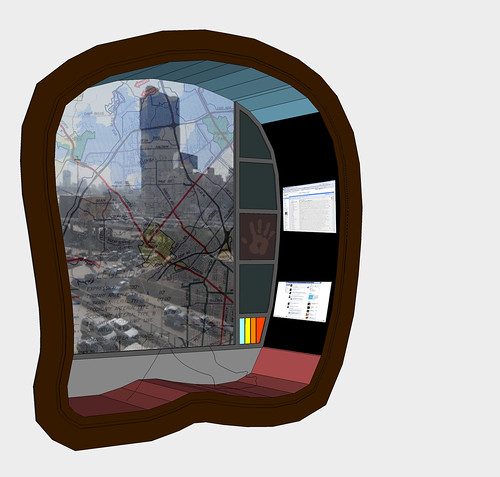 Above: traffic conditions for local neighbourhood displayed on the window
Above: traffic conditions for local neighbourhood displayed on the window7.19.2009
Beds for Cyborgs, Beds for Hermits


7.18.2009
Images From Harvard Medical Guide

 These images are found at the very end of the 1280 pg book. Up until that point the book focuses on describing the human subject (object?) in detailed terms (primarily anatomically with a few excursions into mental manifestations and traits as well), potential irregularities in the form and performance of this subject, and suggestions as to how these irregularities may be ameliorated, suppressed or corrected. The very last section before the appendices is the 4 page section that contains these images, entitled 'Replaceable Parts of Irreplaceable You'. And it seems appropriate that this is the last section as it seems to represent, for me anyways, the way forward towards the unspoken telos of the whole work, perhaps the whole project of medicine. In the end, if the parts of the human object are not corralable back into an easy fit with the initial description (normalcy I think we would call it), then they may be replaced with parts that if not formally consistent with the ideal parts at least conform in their performance.
These images are found at the very end of the 1280 pg book. Up until that point the book focuses on describing the human subject (object?) in detailed terms (primarily anatomically with a few excursions into mental manifestations and traits as well), potential irregularities in the form and performance of this subject, and suggestions as to how these irregularities may be ameliorated, suppressed or corrected. The very last section before the appendices is the 4 page section that contains these images, entitled 'Replaceable Parts of Irreplaceable You'. And it seems appropriate that this is the last section as it seems to represent, for me anyways, the way forward towards the unspoken telos of the whole work, perhaps the whole project of medicine. In the end, if the parts of the human object are not corralable back into an easy fit with the initial description (normalcy I think we would call it), then they may be replaced with parts that if not formally consistent with the ideal parts at least conform in their performance.It's a controversial point, but, seen from this angle it seems like the final cause of medicine could be described this way: the remaking of the human object towards an ideal form, a form notably not defined in physical terms but in terms of performance. In which case, these images of cyborgs are just a step along the way to the ultimate goal which, supposedly, would actually be robots! Now there's a perverse and contentious thought for you: could the essential telos of medicine actually be the design of robots? Well, the title of the section would seem to imply that this is not true with its declaration that 'You' are in fact 'Irreplaceable'. But, as James Geary has pointed out in his lovely The Body Electric, the word 'irreplaceable' here does seem rather forced, to be expressing a thinly concealed anxiety as to exactly how irreplaceable we are.
7.17.2009
A Curious Cabinet
What happens as the medicine cabinet changes, becomes embedded not only with meaning but with 'intelligence'?
 Here I have imagined a cabinet of this sort, the surface of which can display information from three realms - an internal realm (by becoming transparent), your realm (by becoming reflective) and an entirely external realm (by offering news results pertinent to your health, etc).
Here I have imagined a cabinet of this sort, the surface of which can display information from three realms - an internal realm (by becoming transparent), your realm (by becoming reflective) and an entirely external realm (by offering news results pertinent to your health, etc). A cabinet of this sort both ramps up its role in supporting our health and also is exemplary of a sort of remystification of the environment that seems to be happening as pervasive computing becomes more . . . well . .. pervasive.
7.16.2009
Some Pieces of Things
In pursuit of this question I am doing some design work on paper which, when it is better developed I will post here, and I have also started taking some things apart with a thought to re-assembling them in new and hopefully 'evocative' ways. So far I haven't really got into the 'assemblage' phase, but here are some of the results of the 'disassemblage':
7.11.2009
Thesis Abstract Update
6.11.2009
Dirty Projectors / TV on the Radio

The Dirty Projectors are an indie outfit from NYC. I saw them perform a couple of weeks ago as an opening act for TVOTR in Toronto and although I was skeptical at first I think they fully managed to live up to their prestigious following act. TVOTR is exceptionally tight - talented musicians (technicians?) wafting a full-bodied wave of sonorous delight over (and sometimes at) their audience. I was tremendously impressed the last time that I saw them play in Toronto, a couple of years ago now, but if anything I think they've improved their act since then. They just keep getting better and better, perfecting their art.
There is a reason why I was tempted to write 'technicians' above and it is illustrated by the fact that when TVOTR is playing live, one of their premier song-writers, Sitek, stands quirkily at the back, not doing very much. Despite being seemingly an inspired musical thinker, he stands in the background during the performance, not unlike a technician. The front man, Adebimpe, who has amazing stage presence, spends a lot of his time on stage twiddling mysterious (to me) dials while singing. There is something evidently technological about their music, even when they're performing live, although more so on their albums. Their albums are so clearly 'produced', ie. mediated a million times over in the production of the final reproduceble information packet that contains the song, that the fact that they are able to produce such a solid and affecting live show is really admirable. But I also think it is really interesting how the model of making music which treats the listener as an end-user seems to seriously effect their mode of playing. Sitek for instance strums madly away at his guitar not like a virtuoso musician but to produce an 'effect' an industrial-sounding, machinic effect.
 Britney Spears as Cyborg, don't worry it only took 2 minutes
Britney Spears as Cyborg, don't worry it only took 2 minutesI used to have this idea that the rock band structure was similar to Jung's model of the psyche - the persona, the masked face, up front, the conscious guitarist, the unconscious bassist and the conjurer of the collective pounding away on the drums in the back. This model has dissolved and so has the structure of the rock band it seems. For the DP at least, the persona (although still there) melts back into the swarm, playing his strange guitar riffs while letting others take over the primary 'melody'. This is of course a minor version of the rock-band-as-swarm phenomenon. Better examples are bands like the Arcade Fire and Architecture in Helsinki with their small battalions of musicians or canonical examples like God Speed You Black Emperor who used to get 18 people up on stage at one time, or such collaborative acts as The Band. No, band-as-swarm is not new, but it does seem like collectivity is growing in popularity amongst today's bands.
And something else seems evident too. The B-A-S is often accompanied by an attitude like that of the DP - stubbornly human, standing defiantly against CyborgBritney and her friends, an attitude that treasures the collective spontaneity of the musician over the lonely wizardry of the technician.
5.28.2009
Of the Cyborg and the Hermit
I would like to introduce you to two radical images: the Cyborg and the Hermit.
The realm of the cyborg (Haraway) is a highly artificial realm, a realm in which everything is constructed, including what we sometimes call nature. Nothing is pure, everything is transfigured by the curious and unstoppable winds of contingency. The cyborg has no original or everlasting centre. For the cyborg, a creature of communication, objectivity has been replaced by ‘intersubjectivity’ (Rorty). The cyborg is thus pragmatic and accepting of the contingency of its thrownness.
The hermit is everything that the cyborg is not. The hermit seeks the authentic and the real, wants to touch the soil with his fingers. The hermit dreams of home and paradise lost. The hermit seeks to reclaim a lost unity.
Where the hermit relishes in their own fallibility, the shortness of their arm and the limits of their vision becoming badges of their humanity, the cyborg replaces its parts as they fail, extending their reach through vast wireless networks and extending their life into the future. The hermit is nostalgic, but not the cyborg who associates nostalgia with death and for whom the past is gone.
Hand of the Future?
The original work was supposed to address (and the fact that the starting point is an idea might be part of the problem here) our relationship with 'nature' and how this changes as we become increasingly technological beasts.
The following three images are a continuation of this investigation:


5.22.2009
Photographs from Al Purdy's A-Frame
While at the A-frame I attempted to undertake something of a portrait of the A-frame including measured drawings and photographs. Below are a few of the photos I managed to snap:
5.08.2009
Construction of 'Ways of Life' in Architecture
Inclusion and Exclusion in the Construction of Place in Architecture
One of the central victims of the technical homogenization of buildings that has persisted throughout the modern period has been that uniquely grounding quality of space that we call place. Place depends on difference. The preservation and construction of a sense of uniqueness and immediacy in the environment is one of the responsibilities of an architect operating in ‘relational’ space (Harvey’s third type of space, of mental, cultural, social, political dimensions). Norberg-Schultz went so far even as to define architecture as the ‘art of place’[2]. But although this engagement with place entails an attention to the historical condition of a territory, this is not at all to say that architects should be wary of change, of the new. The prescription that the architect must engage with how “life takes place”[3] in a given territory, should imply that the architecture must remain open to many different sorts of life that might take place. As the philosopher Albrecht Wellmer wrote in 1988, “the only choice we have is between different directions in which to progress, different directions for change.”[4] The new is compulsory. To not think so is to flirt with the possibility of exclusion. Recognizing that place is a constructed value, the architect must engage with the human subject through architecture so as to augment their constant, active construction of place. But to do so is always dangerous as the fetishization and propagation of what has been is always so very close to limiting the possibilities of what will be. The architect must listen to the past notions of place and use these as the foundations of ever new constructions. As Wellmer puts it: “It is not only people who dream: cities and landscapes and even materials dream, and perhaps it is the task of architects to interpret these dreams and translate them into built space.”[5] Wellmer pleads that architects “have the courage to intervene instead of merely preserving, the courage to pursue the ‘project of modernity’ instead of resorting to the mere gestures of defence, of conservation, of regression.”[6] Only in this way is it possible to have a regional architecture that resists exclusion.
5.07.2009
Architecture for Cyborgs
What is the role of architecture in an age when our technology is radically transforming us?
While our technology (and our architecture) has always been closely linked to who and how we are, it seems to be moving increasingly closer to us to the extent that you might even say we are becoming cyborgs! A number of important changes are taking place: the extent that we are becoming embroiled in large unfathomable networks is causing disindividuation and re-mystification; the merger of physical reality with virtual reality (the emergence of mixed reality) together with transcendence of the purely visual interface are causing a more harmonious relationship to develop between mind & body; the split self, or ecological model of self is supported by technologies that structurally divide attention, opening the potential for ironic attitudes towards truth, and more pervasive acceptance of plurality and multiplicity.
The architect can play several roles in all of this.
First, it is the architect’s responsibility to carefully calibrate our relationships with larger ecological networks. Given the alienating potential of digital technology, the architect must pay close attention to the scale of the body (or machine-body, or whatever) – to craft and to detail, and to the sensuous engagement between cyborg machine-body and its immediate ecosystem. The architect must also strive to accommodate those aspects of our cyborg-becoming, as listed above, which offer promise for the future. Our architecture must suit the ironic mind. If it structures a way of living and eternalizes images of the ideal life, let them be tolerant and liberal, and open to multiplicity. If the architect must imply stories in the architecture, let those stories have blurred boundaries and multiple endings. Let them be stories instilled with irony.
home is where the hearth is
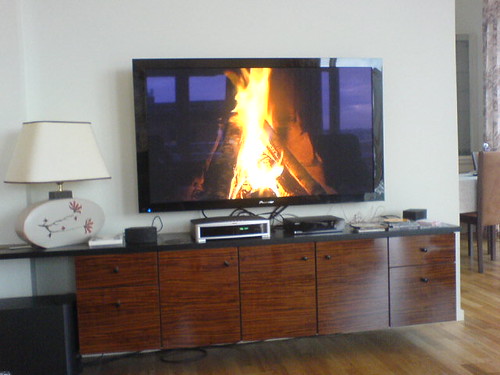 Image taken from here
Image taken from here The fireplace was originally incorporated into buildings in order to keep the indoor environment warm while the temperature outdoors dropped. But it soon came to have a secondary purpose. Being the warmest spot in the house, it became where people would gather. Thus it gained a social function – it became a place for communication and for communion. In an oral culture, the fireplace would have been where common narratives were created and propagated. It was a place of solidarity, a focal point for families and the immediate community. But as technology changed, the hearth changed too. The evolution of indoor heating in the 20th century made the fireplace obsolete in its original capacity. However, largely because of its social function [I think it’s fair to propose that its aesthetic value is linked to its social function], it remained a feature of buildings up until the end of the 20th century. Often, fireplaces were replaced by simulations of themselves such as gas fireplaces. However, the 20th century also replaced the social function of the fireplace. With the popularization of the television, families and friends were soon choosing to gather around it instead of the fireplace. The television became a new sort of electronic hearth.
As with the fireplace, common narratives were created and propagated around the television, although these narratives were being shared on a much larger scale. Also, our engagement with the narratives being spun was far more passive than before. The bodies of television viewers were inert compared to the bodies of those gathered around the fireplace.
Today, the television too is becoming obsolete, with people choosing to go to their computers (and the Internet) for entertainment and communication. For a brief period, as desktop computers, complete with large monitors and ‘towers’, became commonplace, they started to become a new sort of hearth. However, with the progressive miniaturization of technology and the ability for machines to connect to networks wirelessly, desktop computers too are fading away. The hearth, which at one point had been a stabilizing focal point of the architecture, is disintegrating. We carry our hearths around with us in our pockets.
The hearth had served a cosmological purpose, anchoring the immediate community to a place. Solidarity was focused around the hearth, with our networks radiating outward from it. The ecological metaphor of the self as an ecosystem nested within other ecosystems is complicated by the nomadicism of the cyborg at its centre. Now, for an electro-nomadic cyborg, it is as if the world were truly “an infinite sphere of which the center is everywhere and the circumference nowhere,” as Pascal once said. As with the fireplace, our new miniaturized electronic technology allows for communication and communion, and the sharing of common narratives, and it encourages a far less passive body in us than the television or the desktop computer. But in terms of providing a focal point of solidarity for the immediate community, it fails. The new technology still has an alienating component, separating us from our immediate environment while it connects us to larger networks. Architecture gives this level of environment its form, and so architects must respond to this alienation.
Architecture that serves
Architecture is changing along with the rest of our technology. There is the constantly present desire, for instance, for our buildings to be ‘responsive’. Architects, since the beginning of the Modern movement at least, have been incessantly pushing back on the dominating aspects of architecture. In this view, architecture restrains our liberty. It becomes a concrete image of history restricting the freedom of the present. Over time, this desire to free the individual from architecture has taken the form of the open plan, flexible spaces, and temporary buildings that can be reassembled to accommodate changing needs. More recently, architects have been attempting to make architecture that will literally ‘respond’ either to the individual or to other aspects of the environment in real-time. Some examples of this include Jean Novel’s Arab World Institute, where south-facing apertures adjust to levels of sunlight, the MIT-based PlaceLab, where a built-in computer will “sensitively adjust lighting and interior climate in response to your current activities,”[1] and Philip Beesley’s kinetic sculptures, large plastic billowing matrices that move in response to the presence of spectators. Although these projects are very different, they all incorporate contemporary technology to render architecture immediately responsive.
[1] Mitchell, PW, p.64
Architecture as prosthetic membrane; slow architecture vs. alienation
Architecture plays an important role in calibrating our relationships with each other and with the variously scaled networks in which we are enmeshed.
But we shouldn’t think of architecture as just a system of impersonal boundaries. They are actually very personal; these boundaries are very close to our being. As Juhani Pallasmaa has put it, “architecture is the art of reconciliation between ourselves and the world, and this mediation takes place through the senses.”[1] Architecture is at the forefront of our confrontation with the cosmos and should be treated with care.
Architecture has always been close, but as technology increasingly bridges the gaps between the individual and the environment, the design of architecture becomes almost an act of surgery. At the end of the 19th century, Le Corbusier imagined the house as a machine to assist our living. This was a metaphor that represented the machine as separate – a sort of servant to our autonomous humanity. As Anthony Vidler pointed out, the metaphor is changing. Architecture now should be thought of as being much closer to our being than that – as a sort of prosthetic.[2] And indeed, as such visions as the mental control of household appliances via EEG sensors come to materialization, this is no light metaphor – architecture is prosthetic. We are architectural cyborgs.
Now here’s an interesting exercise: If we for ourselves an image of a student in their room at their computer . . . what do we imagine the rest of their room to be like? The room is dark, lit only by the light emanating from the monitor. The student has lost track of time, as David Greenfield, theorizer of the Internet as narcotic, has suggested that he might.[3]
I imagine that the room is largely empty and I imagine that it is a mess. With the amount of attention paid to the world accessed through the windows on their computer, the student has less attention to focus on the environment in immediate spatial proximity to them. As the phenomenon of continuous partial attention causes us to pay less attention to the world about us, it matters a lot less what it looks like. As William James apparently said, our “experience is a narrow thing, bracketed by our own editorial decisions. And it is likewise important to keep in mind the trace that our experience leaves on what we attend to. By observing the space of our hypothetical student, dazed and lost in (or is it on?) the Internet, it is evident that it is not the room that has been experienced; it lacks the trace of dwelling. But, and here is the hope for architects, maybe, the more attention we pay to crafting this immediate level of experience, the room, the more it will have the capacity to bring us back into the present place and moment.
Certain aspects of new technology – the possibilities of haptic interfaces, of a new orality, of mixed-reality, and of the mobility that arises from miniaturization – offer hope of counteracting the alienation from our environment encouraged by so much of our technology. Architects can help wage this battle both by engaging the mind and the body simultaneously and particularly by engaging the body. We need to break through what Mark Kingwell has called the “legacies of abstraction”[4] of the Enlightenment and the ensuing Modern period and ground our expanding phenomenological ecologies in the here and now. Although hearthless, we need to put the rest of architecture to use as we embody ourselves in place.
Perhaps this is why there has been such a resurgence in recent years in interest in the phenomenological understanding of the world amongst architects. As ocular-centric technology has tended to increase our alienation from the ecologies immediately about us, architects such as Juhani Pallasmaa have yearned to reconnect us with them. Perhaps ‘slow architecture’ like that recommended by Peter Zumthor, with its careful attention to dimension and material could be a means of doing this.
